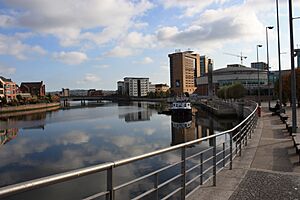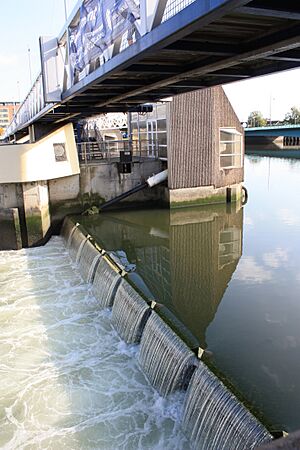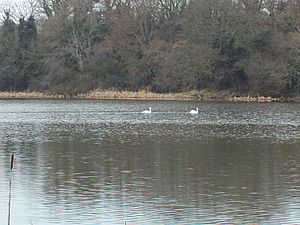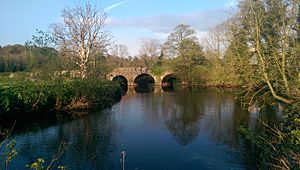River Lagan facts for kids
Quick facts for kids River Lagan |
|
|---|---|
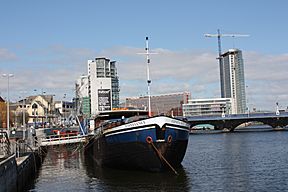
River Lagan at Lanyon Place, Belfast
|
|
| Country | Northern Ireland |
| Counties | Antrim, Down |
| Physical characteristics | |
| Main source | Slieve Croob Northern Ireland 119 m (390 ft) 54°20′24″N 5°58′23″W / 54.340°N 5.973°W |
| River mouth | Belfast Lough 54°41′28″N 5°47′06″W / 54.691°N 5.785°W |
| Length | 86 km (53 mi) |
| Basin features | |
| Basin size | 609 km2 (235 sq mi) |
| Tributaries |
|
The River Lagan is a big river in Northern Ireland. It flows for about 86 kilometers (53.5 miles). The river starts high up on Slieve Croob mountain in County Down. It then travels through towns like Dromara and Dromore. Finally, it reaches Belfast and flows into Belfast Lough, which is part of the Irish Sea.
The Lagan forms a large part of the border between County Antrim and County Down. It begins as a small, fast stream near the top of Slieve Croob. As it flows down the mountain, it joins another stream from Legananny Mountain. The river then turns east towards Magheralin, entering a wide, flat area.
The river collects water from about 609 square kilometers (235 square miles) of farmland. It flows into the Stranmillis Weir, and from that point, it becomes an estuary. This means the river mixes with salty seawater. The upper parts of the river flow through farms. The lower part drains the cities of Belfast and Lisburn. The Lagan has one main branch called the Ravernet River. It also has smaller branches like the Carryduff River, the River Farset, and the Blackstaff River. The water quality is usually good. However, there can be small problems or pollution from farms sometimes. People are working to help Atlantic salmon live in the river again.
Contents
History of the River Lagan
Long ago, in the 2nd century AD, a map book by a person named Ptolemy mentioned a river called Logia. People think the name "Lagan" might come from old words. These words could mean "calf" (a young cow) or "salmon". This shows that salmon might have been important in the river a long time ago.
The Lagan in Belfast City
The city of Belfast got its name from the Irish words Béal Feirste. This means "mouth of the Farset". Belfast was first built on the River Farset. The Farset flows into the Lagan. Over time, the River Lagan became more important than the Farset. Today, the Farset is mostly hidden under the city's High Street.
Making the Lagan Area Better
In 1989, a group called the Laganside Corporation was created. The British government set up this group. Their job was to improve the areas around the River Lagan in Belfast. They worked on many big projects.
Some of these projects include:
- Making the old Gasworks area new again.
- Building the Odyssey, a big place for fun and entertainment.
- Developing Lanyon Place, which includes the Waterfront Hall. The Waterfront Hall is a very important building for the corporation.
The Lagan Weir and Water Quality
One of the first and most important projects was building the Lagan Weir. This weir was finished in 1994 and cost £14 million. The weir helps control the water level in the river upstream. Its main purpose was to stop ugly mud flats from showing at low tide. It has mostly worked, but you can still see some mud flats.
The weir has huge steel barriers. These barriers are lifted as the tide goes out. This keeps the river at a steady water level. The Lagan Weir, along with cleaning the riverbed and adding air to the water, has made the water much cleaner. Because of this, salmon are now coming back to the river. Even otters and seals have followed the fish upstream. They now live in a river that was once very polluted.
Sports on the River Lagan
Many rowing clubs use the River Lagan for sports. These include:
- Queen's University Belfast Boat Club
- Queen's Ladies Boat Club
- Methodist College Boat Club
- Royal Belfast Academical Institution (RBAI) Rowing Club
- Belfast Rowing Club (BRC)
- Lagan Scullers Club ([1])
All the boathouses are located between the Governors Bridge and the Stranmillis Weir.
Cleaning the Riverbed
In September 2010, work started to clean the bottom of the River Lagan. This process is called dredging. It was expected to continue until spring 2011.
The Lagan in Lisburn City
Just like Belfast, Lisburn City Council has also worked to improve the areas around the River Lagan in their city. The main part of their plan was the Lagan Valley Island complex. This building is a new main office for the council. It also has an Arts Centre, places for weddings and meetings, and a restaurant. It opened in 2001. The Lagan surrounds the building on one side, and a channel connected to the river is on the other.
In the late 1800s, the Lagan Navigation was built. This canal connected Lough Neagh to Belfast. It used parts of the river as a waterway for boats. It also took water from other areas for separate canal sections. However, by the mid-1900s, people stopped using the canal, and it fell apart. The M1 motorway (Northern Ireland) was even built across its path.
Today, a part of the canal's towpath has been fixed up. This path runs from Lisburn almost to the center of Belfast. It is now part of National Cycle Route 9. This cycle route will eventually connect Belfast with Dublin.
Wildlife and Fish in the Lagan
Atlantic salmon used to live in the River Lagan. But between 1750 and 1800, they disappeared. This happened when more people moved to the area, industries grew, and a canal was built. The last time salmon were recorded in the river was in 1744.
From 1950 to 1990, the water quality in the river got better. This was because sewage treatment improved. Also, the Lagan Navigation was no longer used. Many factories stopped dumping waste directly into the river. In the early 1970s, a survey found no fish at all in the part of the river that flows through Belfast. However, Brown trout and other fish still lived in the upper parts of the river.
In the 1980s, people started fishing for non-migratory fish in Belfast. Sometimes, people even saw salmon or sea trout. In 1991, people started putting young salmon into the river. By 1993, the first adult salmon returned to the Lagan.
Other plants like Elodea grow in the Lagan. The river is also home to otters and many types of wild birds. There is even a group of yellow-bellied slider turtles living in the river. People think these turtles were once pets that were let go. A seal, known locally as Sammy the Seal, is often seen swimming up the river. He can go as far upstream as Minnowburn.


